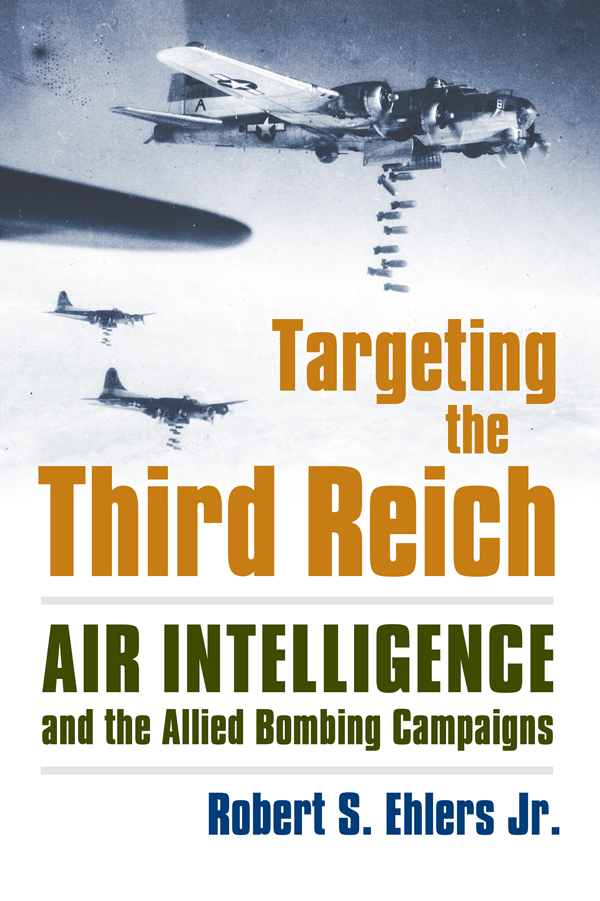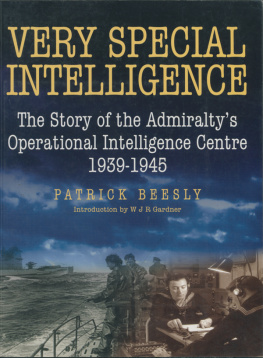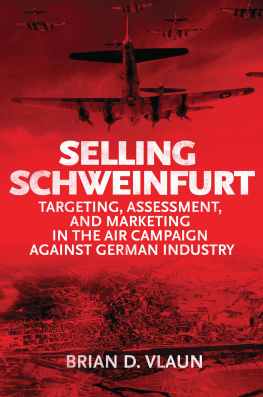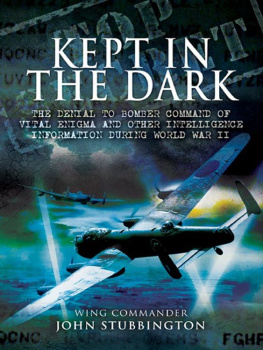
MODERN WAR STUDIES
Theodore A. Wilson
General Editor
Raymond A. Callahan
J. Garry Clifford
Jacob W. Kipp
Allan R. Millett
Dennis Showalter
David R. Stone
Series Editors
TARGETING THE
THIRD REICH
Air Intelligence and the Allied
Bombing Campaigns
Robert S. Ehlers Jr.

2009 by the University Press of Kansas
All rights reserved
Published by the University Press of Kansas (Lawrence, Kansas 66045), which was organized by the Kansas Board of Regents and is operated and funded by Emporia State University, Fort Hays State University, Kansas State University, Pittsburg State University, the University of Kansas, and Wichita State University
Library of Congress Cataloging-in-Publication Data
Ehlers, Robert.
Targeting the Third Reich : air intelligence and the Allied bombing campaigns / Robert S. Ehlers, Jr.
p. cm. (Modern war studies)
Includes bibliographical references and index.
ISBN 978-0-7006-2144-6 (pbk. : alk. paper)
ISBN 978-0-7006-2181-1 (ebook)
1. World War, 19391945Military intelligence. 2. Military intelligenceEuropeHistory20th century. 3. Aerial reconnaissanceEuropeHistory20th century. 4. Bombing, AerialEuropeHistory20th century. 5. World War, 19391945Aerial operations, American. 6. World War, 19391945Aerial operations, British. 7. United States. Army Air ForcesHistoryWorld War, 19391945. 8. Great Britain. Royal Air ForceHistoryWorld War, 19391945. 9. World War, 19391945CampaignsEurope. 10. GermanyHistory19331945. I. Title.
D810.S7E395 2009
940.54'86dc222009021981
British Library Cataloguing-in-Publication Data is available.
Printed in the United States of America
10 9 8 7 6 5 4 3 2 1
The paper used in this publication is recycled and contains 30 percent postconsumer waste. It is acid free and meets the minimum requirements of the American National Standard for Permanence of Paper for Printed Library Materials Z39.48-1992.
TO DR. JOHN F. GUILMARTIN JR.
DECORATED COMBAT VETERAN, SCHOLAR,
MENTOR, FRIEND
CONTENTS
PREFACE
Twice during the past century, first on a modest scale in 19141918 and then on a massive one in 19391945, the Anglo-American Allies unleashed aerial bombardment on their German opponents. Although the 19141918 effort proved limited in its effects, it nonetheless put in place the first operations and intelligence capabilities related to the employment of bombing an enemys industrial and other war-making capabilities. It served, in a sense, as a dress rehearsal for the huge heavy-bomber campaigns against the Third Reich. These played a pivotal role in Allied victory by shortening both casualty lists and the war in Europe. Recently discovered primary sources from German, British, and American archives have prompted a reappraisal of the heavy-bomber campaigns effects on Germanys war effort. Although previously seen as important, they were in fact absolutely central to the speed and decisiveness of the Grand Alliances victory. One of the most startling things about these developments was the degree to which bombing succeeded or failed in its stated aims based on the relative efficacy of air intelligence inputs. The Anglo-American bombing campaigns against Germany relied heavily on air intelligence for targeting information and bomb damage assessment reports. These gave airmen key insights on bombings individual effects and its aggregate effectiveness in support of grand and military strategy.
Air intelligence had already emerged as a new specialty during the Great War, but by 1918, an intellectual infrastructure with organizational and technological components had developed in the British and American air arms. The organizational elements encompassed air staffs with intelligence specialists assigned and unit-level intelligence sections to assess the effects of individual bombing raids. Technologies included reconnaissance aircraft and cameras to collect photographs on the effects of bombing raids. Although these intelligence capabilities, much like bombers and ideas about their proper use, remained embryonic during the Great War, they set a precedent for World War II. Surprisingly, both the operations and intelligence halves of this crucial formative capability survived during the interwar period, despite organizational retrenchment. The emergence of a strategic bombing doctrine and a four-engine bomber, the Boeing B-17, in the United States heralded the arrival of a mature bombing capability, while the threat of war prompted British civilian and military leaders to grapple with the same issues and, to a much greater degree than their American allies, begin building a new air intelligence organization.
Although early British bombing operations were generally ineffective, they allowed intelligence specialists at the Central Interpretation Unit, Ministry of Economic Warfare, Research and Experiments Division, and other agencies to learn their trade. The combination of these organizations with new technologies, including reconnaissance Spitfire and Mosquito aircraft with advanced cameras, resulted in very effective, but by no means perfect, air intelligence capabilities. Once American air intelligence personnel and reconnaissance aircraft began arriving in 1942, a highly effective Anglo-American air intelligence organization emerged. Two of the most important aspects of this new air intelligence capability and its successes were its interagency naturethe machinery put in place to share insights quickly among every interested organizationand its distinctly combined flavor. As leaders in this field, the British worked brilliantly with their American pupils, and in the process helped give birth to Americas first air intelligence capability. Anglo-American analytical expertise, committee structures, and rapid means of intelligence dissemination and incorporation into operational plans proved crucial to the larger war effort.
After the RAF Bomber Commands very effective attacks on the Ruhr in 1943, and once the Americans gained air supremacy in the daylight skies over the Reich in early 1944, heavy bombers engaged in three important campaigns, first against French and Belgian railroads to isolate Normandy from German reinforcements and resupply, then against Germanys oil industry, and finally against Germanys railroads and inland waterways. Air intelligence officers played a crucial role by giving airmen accurate insights into these campaigns effectiveness. The first campaign played a vital role in the collapse of German resistance in Normandy. The second had disastrous effects on German fuel production and thus on the Wehrmachts combat power from July 1944 to VE Day. The third undermined Germanys war economy. The aggregate results were cataclysmic for Germanys war effort. Approaching these campaigns from an air intelligence and operational perspective, rather than a purely operational one, highlights their significance.
On a less positive note, there were also instances in which political and military leaders ignored available intelligence, refused to guide their actions according to the insights it provided, or twisted it to suit their own arguments about strategy and operations. The consequences of this behavior ranged from strains within the Anglo-American camp to the unnecessary commitment and loss of aircrews over Nazi-occupied Europe. Clearly, intelligence had its limits. It was an inherently political commodity working within a huge and often adversarial command structure and the worlds first intelligence interagency structure.
Next page











